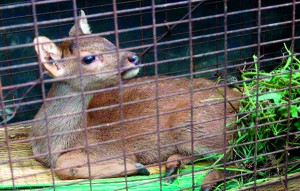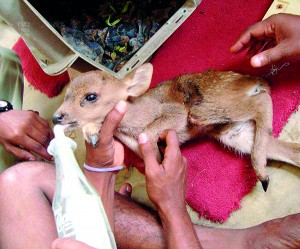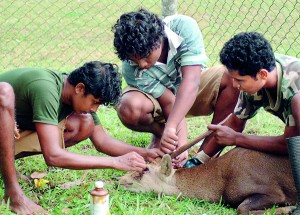News
Island sanctuary for critically endangered Hog Deer
View(s):By Malaka Rodrigo

A Hog Deer in safe hands
Last year was not a good year for wildlife and the environment, so it was good to start the New Year on a positive note with a happy environment story.
As part of a conservation programme, two female Hog Deer were released on an island in Lunu Ganga last weekend. The animals were transported in wood crates from the Hiyare Wildlife Rescue facility to Bentota in the back of a double cab, and then by catamaran to their new island home. The release was arranged by the Wildlife Conservation Society of Galle (WCSG), in association with the Department of Wildlife Conservation.
The Hog Deer (Axis porcinus), known locally as “Wil Muwa” or “Gona Muwa”, is the country’s most threatened deer species. The rare animal lives in isolated pockets between Benthara and Galle.

Infant Hog Deer bottle-fed by WCSG members
The Hog Deer rehabilitation and rescue programme began in 2009 at the Hiyare Wildlife Rescue facility, with support from the Nations Trust Bank. The Wildlife Conservation Society of Galle has rescued many injured Hog Deer from their original habitats in Elpitiya and Balapitiya. Hog Deer live in marshy habitats and have adapted to cinnamon estates, a common feature in that part of the country. Unfortunately, their intrusion into human habitation has resulted in many road accidents.
Young Hog Deer are easy prey to dogs and water monitors (kabaragoya). Female Hog Deer keep their new-born hidden in the tall grasses that grow around marshy land. The two Hog Deer released into the Lunu Ganga were attacked by water monitors in separate incidents. They were only a few weeks old when they were handed over to the Wildlife Conservation Society Galle a year ago. One had a fractured leg and was treated at the Hiyare Animal Welfare centre. The baby animals were first bottle-fed and then hand-fed with grasses and plant shoots.
Looking for a good place to release the animals, the Wildlife Conservation Society Galle heard about an island in the Benthara Lagoon that was ideal habitat for Hog Deer. Jagath Gunawardane identified the island,

Adult male Hog Deer injured in a road accident is treated
known to locals as “Hon Duwa”, which was gazetted as a wildlife sanctuary in 1973. Over the past 18 months, the Geoffrey Bawa Trust and the Wildlife Conservation Society have been preparing the one-and-a-half acre island by growing plants that Hog Deer eat.
Dr. Tharaka Prasad of the Department of Wildlife Conservation told the Sunday Times that the island is ideal for Hog Deer as it combines scrub jungle, swamps and mangroves. The department has attempted to breed Hog Deer at the Horagolla national park, but with no results so far.
The Hog Deer is on the 2012 Red List as a critically endangered species.
| Who brought the rare animal to Sri Lanka?
The Hog Deer (Axis porcinus) – “Wil Muwa” or “Gona Muwa” in Sinhala – is a critically endangered deer species that lives in isolated pockets between Benthara and Galle. The deer species is believed to have been introduced to Sri Lanka. The animal is not found in South India. The deer may have been accidentally or deliberately unloaded when Galle harbour was used as transit point in early colonial times. Madura de Silva, president of the Wildlife Conservation Society of Galle, says that even if the Hog Deer were an introduced species, it could adapt during a century of living in isolation. Habitat loss is the Hog Deer’s main threat. The species was believed to have become extinct when a few animals were spotted some decades ago. |
Follow @timesonlinelk
comments powered by Disqus



















